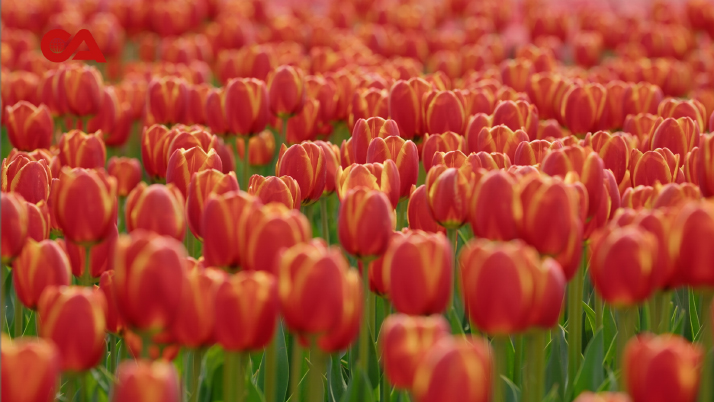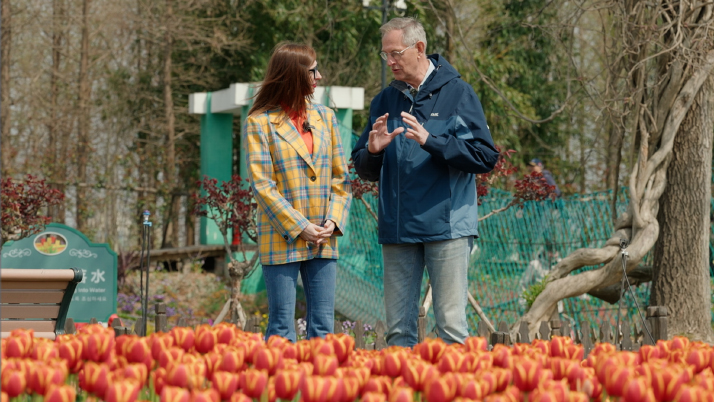
Even on weekday mornings, tourists flock to the park in droves. According to data from the government of Dafeng, during this year’s May Day holiday (May 1-5) alone, the number of tourists exceeded 690,000.
Behind the iconic tulips that brigthen up the park is Nicolaas Kaaijk, a Dutch horticulturist who has brought his homeland’s specialty to China.
Born into a tulip-growing family in 1956, Kaaijk has nurtured a deep affection for tulips, the Dutch national flower, from a very young age. By the time he was 7, he had already learned to trim blossoms and identify diseased bulbs. At age 10, he could drive a tractor to help his parents harvest tulip bulbs. At 17, upon graduating from an agricultural technical school, Kaaijk took over the family business and began his entrepreneurial journey as a gardener. “Ever since I was a child, I’ve had a dream to spread tulips to more places in the world,” he told Beijing Review.
In 1998, armed with both the passion and professional skills to promote tulips, Kaaijk came to China, and has successively engaged in the cultivation and sales of tulips in several places across the country. As Dafeng set out to build a “Holland Town” in 2013—a tourist destination, Kaaijk was invited to become the technical advisor for the Holland Flower Park, initially part of the Holland Town. He embraced the project and over one decade later, he’s still shaping the landscape.
From wasteland to wonderland
The Dutch-themed tourist attraction was not created randomly, but in order to commemorate and continue the friendship between the two countries. A century ago, Dafeng was an unforgiving stretch of saline-alkali land, where crops struggled and farmers despaired. In 1919, Chinese national industrialist Zhang Jian invited Dutch hydraulic engineer Hendrik de Rijke to help design and construct a world-class drainage system. This pioneering infrastructure transformed the land, enabling dozens of square km of cotton to grow in this soil. This chapter of history, and the waterways it left behind, led Kaaijk to believe in the future of tulip cultivation in this region.
The development of the tulip industry involves series of fundamental technical processes, including bulb storage, soil balancing and field management. In particular, large-scale cultivation and bulb propagation had long remained uncharted territory in China. Kaaijk devoted immense time and energy to growing the flowers.
“At the very beginning, growing tulips in Dafeng relied entirely on the importation of flower bulbs, which incurred substantial costs. Furthermore, owing to the disparities in climate and soil conditions, the survival rate of the flowers was relatively low, and some blooms failed to achieve satisfactory results,” he recalled.

“I had tried to plant small bulbs first and cultivate them into larger ones in one or two years before they blossomed, so that they could better adapt to the soil environment here,” Kaaijk said as he introduced one of the methods he had attempted. “Also, because the climate here is much warmer than that in the Netherlands, the probability of pests and viruses occurring increases accordingly. So I selected and cultivated virus-resistant varieties,” he added.
During the 2014 Spring Festival, China’s biggest annual holiday, Kaaijk organized his first indoor tulip exhibition in China. Buoyed by the warm reception, he pressed forward and decided to take on a greater challenge: a large-scale outdoor tulip display. In just three years, he and his team managed to transform the Holland Flower Park into the only scenic destination in China capable of showcasing tulips outdoors for eight consecutive months every year.
Today, the 2-square-km Holland Flower Park is home to 30 million tulip blossoms spanning over 300 varieties. It has collected and preserved 13 species of wild tulips native to China and achieved the independent propagation of eight cultivated varieties. And yet, this floral sea stretches far beyond, as a vast plan is unfolding to upgrade the experience for its tourists.
“We are now working on a tulip-picking garden, so that the tourists take home the tulips they handpicked. It is noteworthy that all the tulips there (Holland Flower Park) are replanted. We collected the bulbs planted in the Holland Flower Park last year and transplanted them here. This way, the bulbs are fully utilized, which is both economical and environmentally friendly,” Kaaijk explained.
The language of tulips
In recent years, the Holland Flower Park has grown in renown nationwide. Featuring expansive flower fields and European-style architecture, the park has become a popular destination for couples to have their wedding pictures taken. Consequently, the park has developed related services, including wedding planning, floral arrangement, performances and professional photography.
The park also hosts a flower and potted plant market, a children’s playground, dining venues, a cinema, a camping area and resort hotels—thoughtfully designed to cater to visitors of all ages.
The decade-long tulip cultivation has not only yielded significant economic gains, but also fostered lasting cultural ties between the two nations. “The Flower Park has naturally fostered trade between the Netherlands and China—but I truly hope for a deeper exchange,” Kaaijk said.
Beyond his work in fields and warehouses, he has actively engaged with Dutch universities and floriculture associations, advocating for collaboration between the Holland Flower Park and the Dutch Wageningen University & Research, one of the leading international universities in the field of healthy food and living environment, to secure greater technical support. He has also taken the initiative to organize Sino-Dutch floriculture and cultural tourism forums, as well as trade fairs, inviting renowned Dutch experts, business leaders and government officials to China for in-depth interactions.
Now, the Holland Flower Park is a platform for Dafeng to further expand its exchange and cooperation with Holland in different fields like culture, tourism and education.
“Coincidentally, the language of tulips is love and friendship. I brought tulips from Holland with the hope that they would flourish on Chinese soil and, even more so, I aspire for these tulips to convey the love and friendship they stand for,” Kaaijk said. –The Daily Mail-Beijing Review news exchange item





